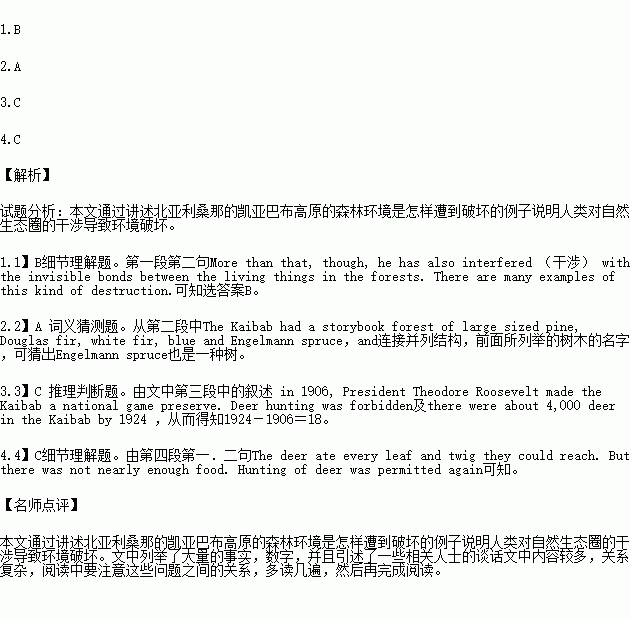题目内容
Modern man has cleared the forests for farmland and for wood, and has also carelessly burned them. More than that, though, he has also interfered(干预) with the invisible bonds between the living things in the forests. There are many examples of this kind of destruction. The harmfulness of man’s interference can be seen in what happened many years ago in the forest of the Kaibab plateau (凯亚巴布高原) of northern Arizona. Man tried to improve on the natural web of forest life and destroyed it instead.
The Kaibab had a storybook forest of large-sized pine, Douglas fir, white fir, blue and Engelmann spruce. In 1882 a visitor noted, "We, who have wandered through its forests and parks, have come to regard it as the most enchanting(迷人的)region it has ever been our privilege to visit. "This was also the living place of the Rocky Mountain mule deer. Indians hunted there every autumn to gather meat and skins. The forest also had mountain lions, timber wolves and bobcats that kept the deer from multiplying too rapidly.
Then, in 1906, President Theodore Roosevelt made the Kaibab a national game preserve. Deer hunting was forbidden. Government hunters started killing off the deer’s enemies. In 25 years’ time, 6,250 mountain lions, wolves and bobcats were killed. Before the program, there were about 4,000 deer in the Kaibab, by 1924, there were about 100,000.
The deer ate every leaf and twig they could reach. But there was not nearly enough food. Hunting of deer was permitted again. This caused a slight decrease in the deer herd,but a far greater loss resulted from starvation and disease. Some 60 percent of the deer herd died in two winters. By 1930 the herd had dropped to 20,000 animals. By 1942 it was down to 8,000.
1. The destruction of the environment of the Kaibab resulted from ________ .
A. turning the forest into cultivated land
B. interfering with natural cycle of forest life
C. forest fires caused by man’s carelessness
D. cutting the trees for building materials
2. "Engelmann spruce"(Para. 2)is most likely the name of ________ .
A. a tree B. an animal
C. a mountain D. a game
3. The number of the deer in the Kaibab had increased enormously in
________ years’ time.
A.25 B.6 C.18 D.12
4.Years later, large numbers of deer in the Kaibab died mainly because of
_______.
A. the cold
B. the organized kill
C. the shortage of food
D. the poor management
 阅读快车系列答案
阅读快车系列答案
